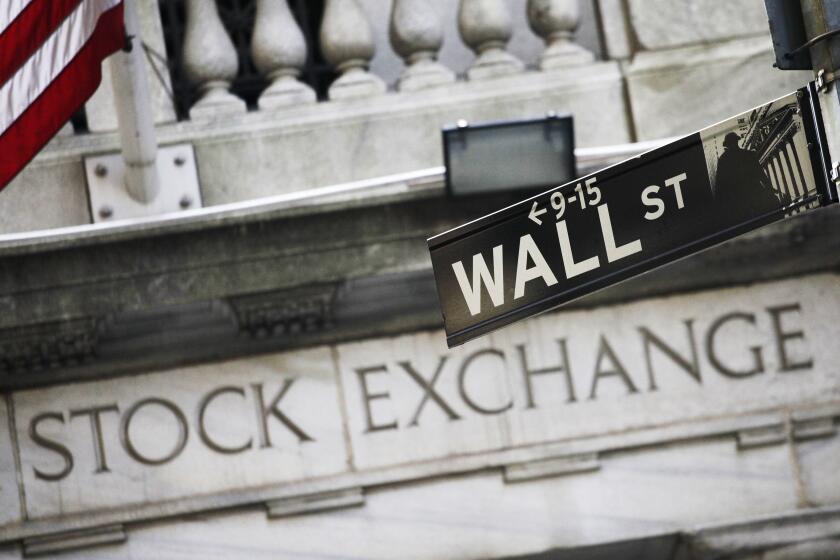Big Mutual Fund Buys Don’t Always Lock In a Rally
- Share via
By nearly all accounts, Americans are pouring cash into stock mutual funds at a record pace this month. So no wonder the stock market is hitting record highs, right?
Well, maybe. There certainly can be a correlation between the public’s hunger for stock funds and the market’s near-term direction. But perhaps not as dependable a correlation as many investors might assume, despite the mutual fund industry’s reputation as Wall Street’s resident 800-pound gorilla.
In fact, people who believe that the U.S. stock market can only soar over the next decade--because of a steady flow of incoming cash from nest-egg-building baby boomers--may want to reconsider. It doesn’t necessarily have to be so.
A little history makes the point. In 1994 investors poured a net $119.3 billion in fresh cash into stock mutual funds, continuing to buy even as interest rates surged. Fund managers, in turn, made net purchases of $116.6 billion worth of stock that year, meaning their purchases exceeded sales by that amount (i.e., they dutifully put investors’ dollars to work in the market).
Impressive numbers. But stock prices fell anyway in 1994, on balance. The Standard & Poor’s 500 index lost 1.5% for the year, its first annual decline since 1990.
*
Was that a fluke? Some people might argue so. Yet relative non-correlation between fund cash flow and market performance also occurs in reverse. Consider what happened in 1995. The S&P; 500 index posted its best annual gain since 1958, rising 34.1%. You might assume that that was because the domineering mutual fund industry bought more shares than ever.
Not so. Fund managers took in a huge amount of cash last year from small investors, as in 1994. But the funds didn’t put as much of that cash to work: fund net purchases of stock totaled $103.6 billion in 1995, 11% below 1994 levels, says the industry’s trade group, the Investment Co. Institute. So the S&P; index’s stellar performance in 1995 occurred without record share purchases by the funds.
The year 1988 was much more striking for its non-correlation between fund cash flow and market performance. Fund managers were net sellers of $16.1 billion in stock in that year, in the aftermath of the 1987 market crash. Yet the S&P; index stunned most Wall Streeters by rising 12.4% for the year, then rocketing 27.3% in 1989.
Of course, these numbers don’t paint a complete picture of the market environment at any given point. In 1988, corporate demand for stock--in the form of takeovers and share buybacks--more than made up for the mutual funds’ net selling.
In 1995 the funds’ net purchases of stocks lagged 1994 purchases, but it still might be true that the S&P; index only performed so well in 1995 because mutual funds’ buying was concentrated in specific stocks--namely, the big consumer growth stocks in the S&P;, such as Coca-Cola and Merck.
Nonetheless, some Wall Street veterans say the basic point worth making is that stock price changes are determined by more than the absolute amount of money flowing into the market.
Vincent Warther, assistant professor of finance at the University of Michigan, has studied mutual fund cash flows and their effect on the market, and he believes that steady streams of money into the funds--such as what’s coming in regularly via retirement accounts--are far less significant in setting the market’s course than is widely perceived.
“It’s not the gross level of flows that correlate with returns,” he insists. Rather, it’s the “unexpected” cash flow that suddenly makes the market react, he says.
One can argue about what constitutes “unexpected” money, but Warther is just restating what most pros already know to be true: Stock prices are set by what happens at the margin, by the psychology of the people trading at a particular moment, notes Avi Nachmany, analyst at fund-research firm Strategic Insight in New York.
It’s the urgent buyer at the margin who forces prices higher. And it doesn’t necessarily take an army of those investors--or a huge amount of cash in their hands--to fuel a market surge.
Unfortunately, the reverse also is true: It doesn’t take a huge amount of selling to force stock prices down. All you need is for the investors at the margin to begin lowering the prices they’re willing to pay--because of a change in interest rates, say, or shifting expectations for corporate profits, or a rise in the supply of new stock--and a bull market can quickly turn into a stagnant market, or worse.
Obviously, it’s better for Wall Street to see big cash flows into mutual funds than to be confronted with outflows. But a steady inflow of money into the funds won’t by itself guarantee the bull market’s longevity.
(BEGIN TEXT OF INFOBOX / INFOGRAPHIC)
Demand vs. Results
The level of mutual funds’ net purchases of common stocks in any given year doesn’t necessarily correlate with the stock market’s performance.
*--*
Funds’ net purchases of common stocks S&P; 500 index Year (billions of dollars) price change 1995 +$103.6 +34.1% 1994 +116.6 -1.5% 1993 +126.5 +7.1% 1992 +66.2 +4.5% 1991 +41.2 +26.3% 1990 +20.0 -6.6% 1989 +1.2 +27.3% 1988 -16.1 +12.4% 1987 +23.0 +2.0% 1986 +16.6 +14.6% 1985 +8.2 +26.3%
*--*
Source: Investment Company Institute; Standard & Poor’s
More to Read
Inside the business of entertainment
The Wide Shot brings you news, analysis and insights on everything from streaming wars to production — and what it all means for the future.
You may occasionally receive promotional content from the Los Angeles Times.










